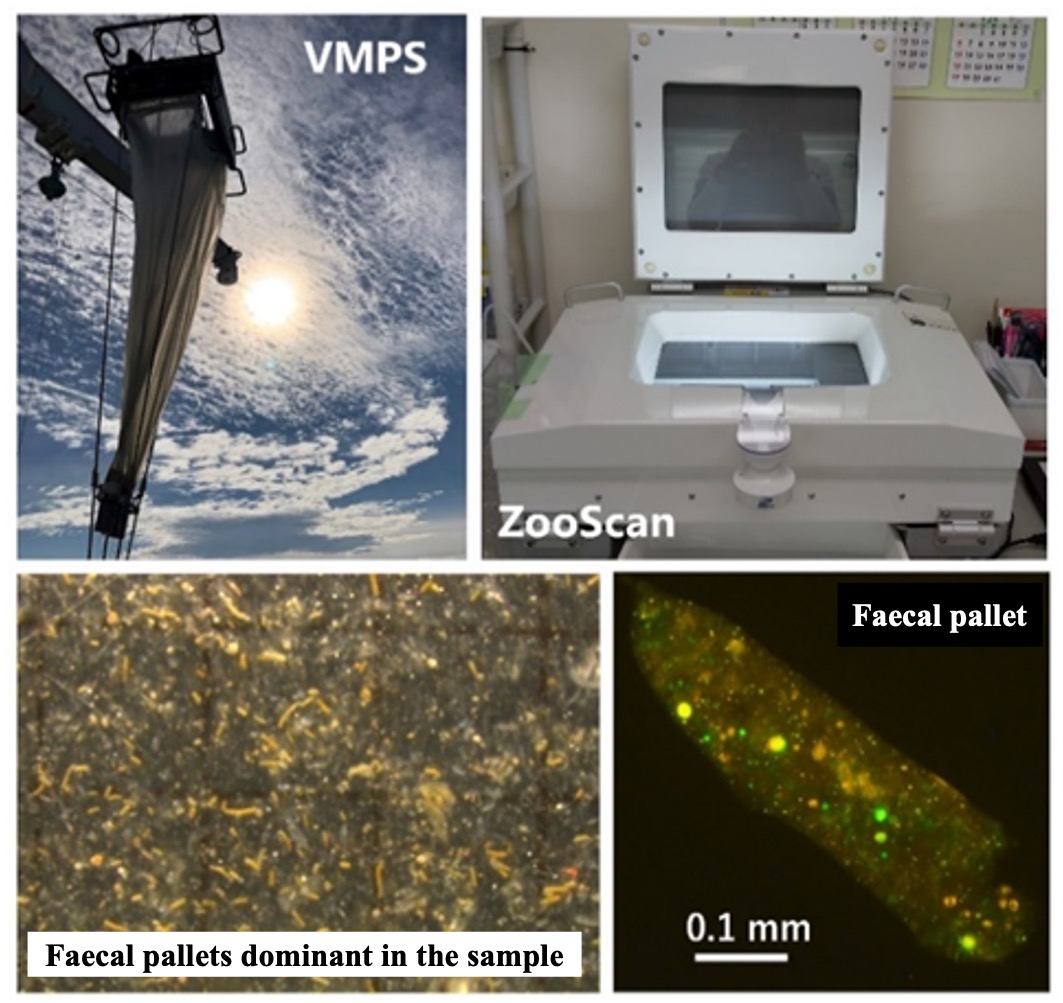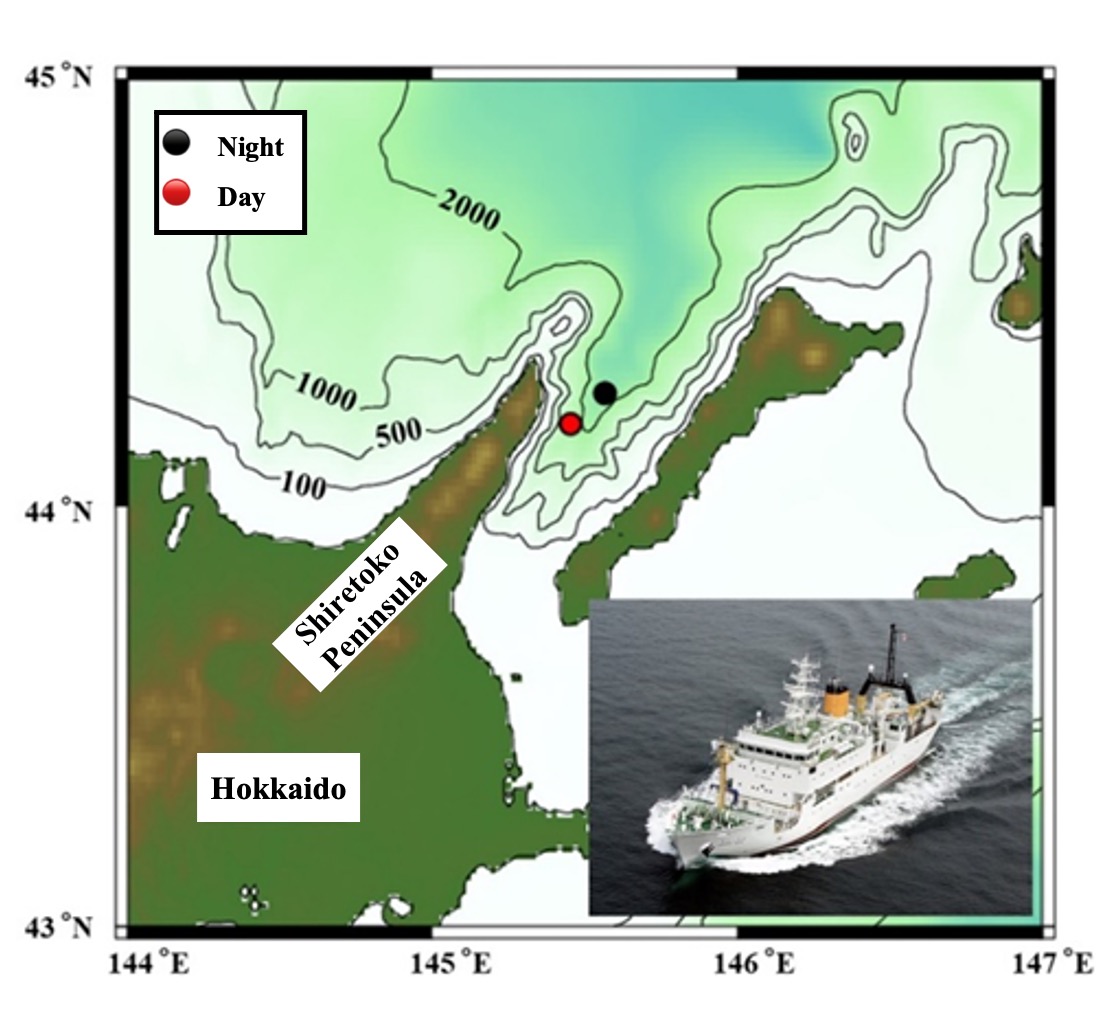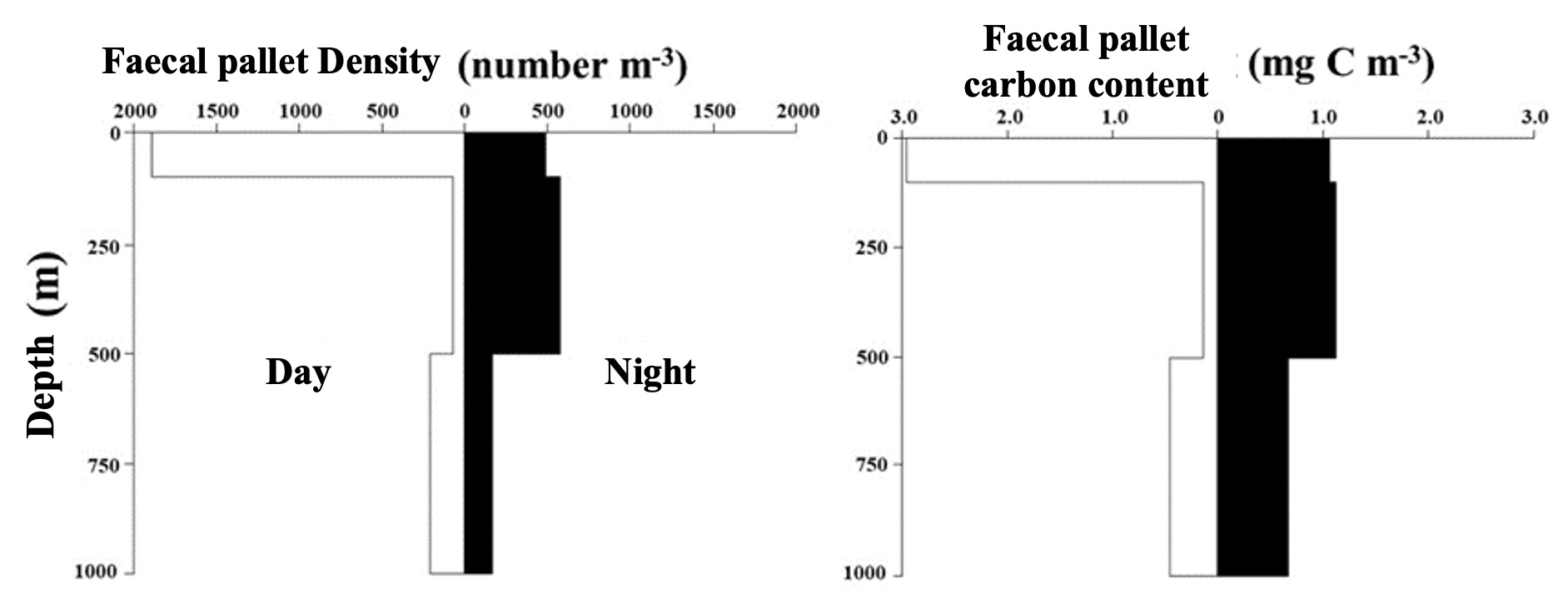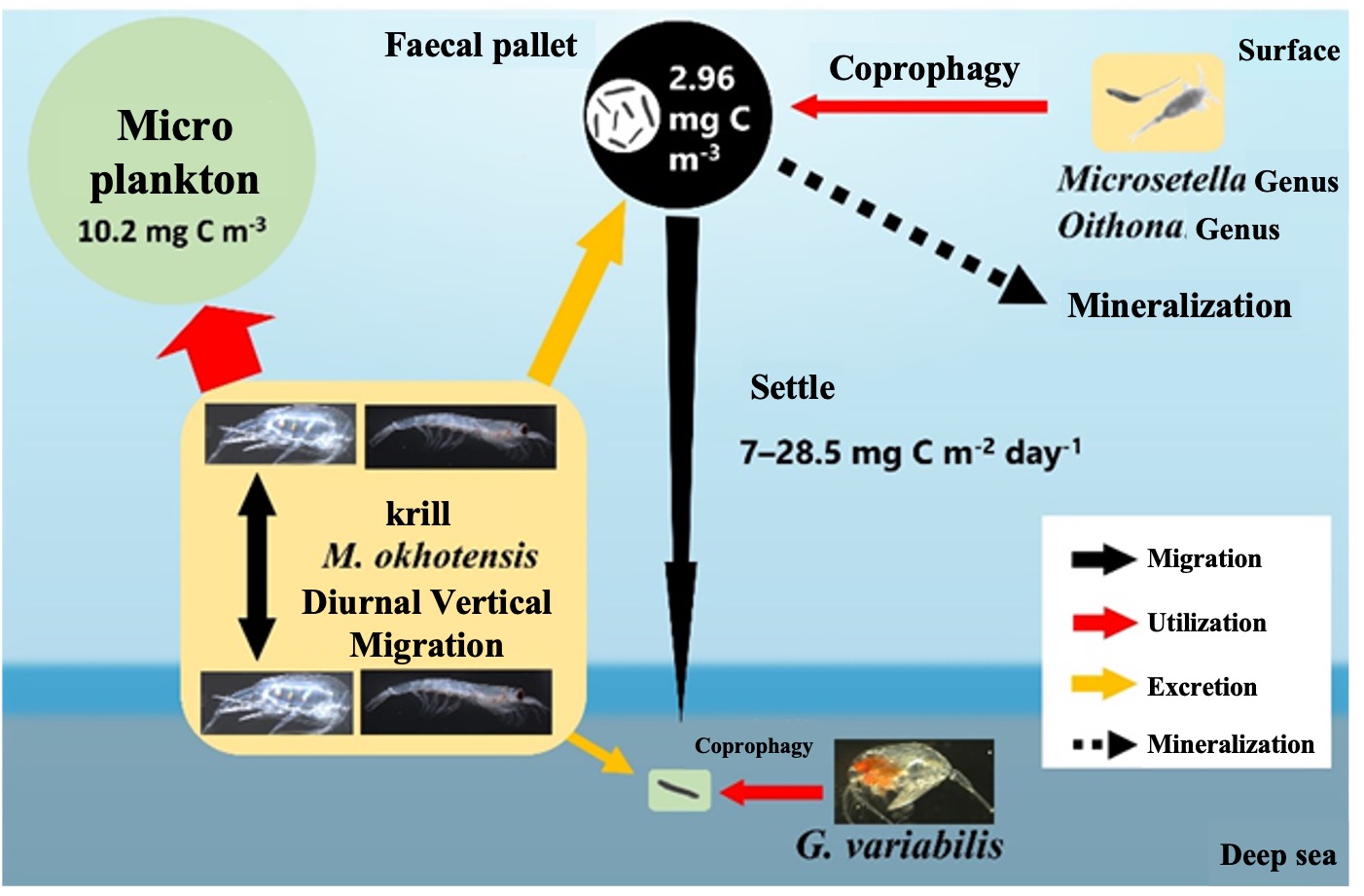A New Quantitative Method for Zooplankton Faecal Pellets in the Field
セクションアウトライン
-
・Developed a new method for the quantification of zooplankton faecal pellets, a major driver of the material cycle in the oceans.
・Imaging scans of plankton net collection samples with fine mesh were analyzed.
・Succeeded for the first time in the world in evaluating day-night differences in the amount and size of zooplankton faecal pellets in the field.
-
A research group led by Associate Professor Atsushi Yamaguchi and Assistant Professor Kohei Matsuno of the Faculty of Fisheries Sciences, Hokkaido University has developed a new method for analyzing the quantity and size of zooplankton faecal pellets in the field using zooplankton samples collected in the southern Sea of Okhotsk during the summer season by stratified sampling at depths between 0 and 1000 m. The samples were collected by day and night, and a large number of zooplankton faecal pellets were found in the samples.
Material cycles in the oceans influence global environmental change. In addition to physical diffusion, sedimentation and transport by faecal pellets excreted by zooplankton are known to play a major role in driving the material cycle in the oceans. Until now, the quantitative evaluation of zooplankton faecal pallets have been conducted using a sediment trap, which is moored at a given depth in the ocean for a certain period of time and collects sedimentation particles from the upper layer of the ocean. However, the collection by sediment traps requires a mooring period of at least 2 to 3 days, and it has remained unclear whether there are day-night differences in the amount and size of zooplankton faecal pallets in the field. The research group conducted stratified sampling with a fine-mesh (63 µm) plankton net and analyzed the collected samples using an imaging scanner to successfully evaluate the amount and size of zooplankton faecal pallets in the field.
The results of this study provide important knowledge in oceanography as a method that leads to accurate quantitative evaluation of zooplankton faecal pallets, which are the driving force of material cycles in the ocean.

upper left: Vertical Multiple Plankton Sampler (VMPS). Fine mesh (63 µm) allows for layer-by-layer sampling.
lower left: Zooplankton faecal pallets that appeared in large numbers and were dominant in the sample.
upper right: Imaging scanner for zooplankton (ZooScan). Capable of quantifying the exact size and number of faecal pallets.
lower right: Fluorescence micrograph of zooplankton faecal pallets. Phytoplankton cells with fluorescent ability in faecal pallets appear like stars.
-
Material cycles in the oceans influence global environmental change. In addition to physical diffusion, sedimentation and transport of faecal pallets, excreted by zooplankton feeding on microplankton in the surface layer, are known to be important in the material cycle in the ocean. Quantitative sampling of zooplankton faecal pallets is generally performed by mooring a device called a sediment trap, which collects sedimentation particles from the upper layer. However, since the sampling of faecal pallets with a sediment trap requires a mooring period of 2 to 3 days, it has remained unclear whether there are day-night differences in the amount and size of zooplankton faecal pallets in the field. In the southern Sea of Okhotsk during the summer, the research group conducted stratified day/night sampling between 0-1000 m depth with a fine-mesh zooplankton net, which can also collect faecal pallets, and analyzed the samples using an imaging scanner to develop a new method for quantitative evaluation of faecal pallets.
In the southern Sea of Okhotsk in summer, low-salinity seawater from melting sea ice is warmed by sunlight, and high-temperature, low-salinity seawater with very light specific gravity is seen on the surface layer. The underlying water is low-temperature, high-salinity brine water that is discharged during the winter ice formation process, resulting in the development of a pronounced pycnocline. The zooplankton community is dominated by krill and copepods Metridia okhotensis, which are capable of diurnal vertical migration across this strong pycnocline. The research group quantitatively collected micro-, medium-, and large-sized zooplankton, which are the food of these zooplankton, and analyzed their community structure at the species level, as well as sedimentation and transport by faecal pallets. -
On June 29-30, 2019, water samples and net samples were collected by the training ship Oshoro-Maru attached to the Faculty of Fisheries Sciences, Hokkaido University at two stations on the east coast of Shiretoko Peninsula in the southern Sea of Okhotsk (Figure 1). Samples were fixed and brought back, and microplankton species and sizes were measured under a fluorescence microscope. Net sampling was conducted by day and night vertical segmented sampling (p1. Figure) in three layers between 0 and 1,000 m depth using a 63 µm mesh VMPS*1, and horizontal towed sampling using a mid-water trawl. VMPS samples were divided on board, live zooplankton were sorted by species and developmental stage, reared in filtered seawater under in situ temperature conditions, and faecal pallets excreted were fixed. The remaining VMPS and MOHT*2 samples were also fixed and brought back to the laboratory. The zooplankton that appeared in the samples were counted by species and developmental stage, and their sizes were measured and expressed in carbon. For faecal pallets that appeared in large numbers in the VMPS samples, image data were acquired using the ZooScan*3 imaging scanner (see figure), and the number and size of the faecal pallets were quantified and expressed as carbon content.
-
The microplankton present at the site was 10.2 mg per cubic meter. The zooplankton was dominated by krill and copepods Metridia ochotensis, which are diurnal vertical migrants, and their feeding pressure was estimated to be 21% of the daily microplankton abundance. Zooplankton faecal pallets were abundant in the shallowest layer (0-100 m) during the daytime, reaching a maximum of 1,888 per cubic meter and 2.96 mg of carbon (Figure 2). There was a diurnal variation in faecal pallet size, with larger faecal pallets being observed only at night. This indicates that the larger faecal pallets settle faster, so that faecal pallets excreted during the night settle into the deep sea during the night and are not observed during the day. Observations of faecal pallets during rearing experiments revealed fluorescent phytoplankton cells in the faecal pallets (p.1, Figure). In addition, at depths of 500-1000 m, the mesopelagic copepod Gaetanus variabilis fed on feces excreted by zooplankton in the upper layer (Fig. 3), indicating that repacking is an important behavior for deep-sea organisms. This is a direct indication that organic matter in the form of faecal pallets is an important food resource for deep-sea organisms.
-
This study has shown that a method for quantifying faecal pallets of zooplankton using a fine-mesh plankton net and an imaging scanner is effective. This method can reveal day-night differences in the abundance and size of faecal pallets, which could not be determined by conventional sediment traps because they require a 2 to 3 days moored sampling period. Zooplankton faecal pallets are not only an important driver of the material cycle in the ocean, but also serve as a food resource for zooplankton in the field, especially in the deep sea. The fact that there is a clear diurnal difference in the amount and size of zooplankton faecal pallets is expected to have a significant impact on the ecology of deep-sea organisms that feed on them, and is a technique that is expected to be applied in future deep-sea biological research.
The results of this research will make it possible to more accurately quantify the amount of faecal pallets of zooplankton in the ocean, which is expected to lead to an accurate quantitative evaluation of the material cycle in the ocean, which has a significant impact on global environmental change.
-

Figure 1. Sampling station for this study and the Oshoro-Maru, a training ship attached to the Faculty of Fisheries Sciences, Hokkaido University, where the sampling was conducted.

Figure 2. Day-night depth distribution of zooplankton fecal density (left) and carbon content (right) in the southern Sea of Okhotsk during summer. White indicates daytime, black indicates nighttime.

Figure 3. Schematic diagram of zooplankton biomass and mass transport through fecal grains in the southern Sea of Okhotsk during summer. All units of numbers in the figure are carbon content (mg C m-3 or mg C m-2 day-1).
-
*1 VMPS … Name of plankton sampling nets by layer.
*2 MOHT … Name of the midwater trawl net.
*3 ZooScan … Name of Zooplankton Scanner.
-
・Paper title
Vertical distribution, standing stocks, and taxonomic accounts of the entire plankton community, and the estimation of vertical material flux via faecal pellets in the southern Okhotsk Sea
・Authors
Daiki Kojima1,Yusuke Hamao1,Kanako Amei1,a,Yutaka Fukai1,b,Kohei Matsuno1,2,Yoko Mitani3,c,Atsushi Yamaguchi1,2(1Graduate School of Fisheries Sciences, Hokkaido University, 2Arctic Research Center, Hokkaido University, 3Field Science Center for Northern Biosphere, Hokkaido University, Current affiliation: aAtmosphere and Ocean Research Institute, The University of Tokyo, bHokkaido Research Organization, Fisheries Research Department Kushiro Fishereies Research Institute, cThe Wildlife Research Center, Kyoto University)
・Journal
Deep-Sea Research Part I(Journal of Oceanography)
・DOI
10.1016/j.dsr.2022.103771
・Date of Publication
Monday, April 4, 2022 (online publication)

